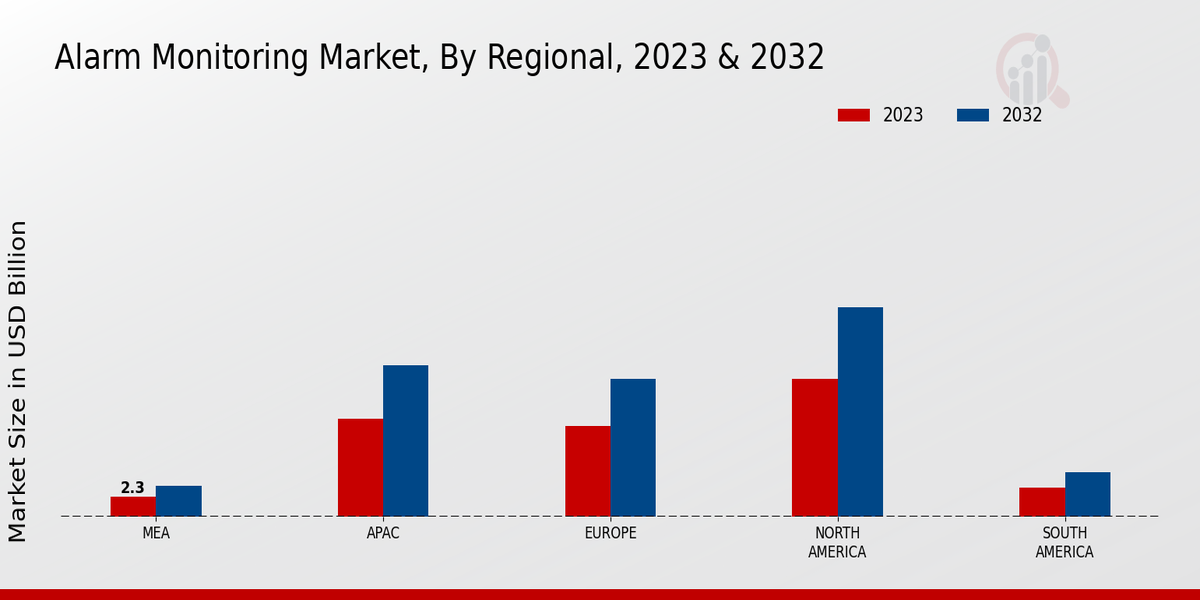Rising Security Concerns
The Global Alarm Monitoring Market Industry experiences a notable surge in demand due to escalating security concerns among residential and commercial sectors. As urbanization intensifies, the need for effective security solutions becomes paramount. For instance, in 2024, the market is projected to reach 44.4 USD Billion, reflecting a growing awareness of safety measures. This trend is further amplified by increasing crime rates in various regions, prompting individuals and businesses to invest in alarm monitoring systems. Consequently, the industry is likely to witness sustained growth as consumers prioritize security, thereby driving the overall market dynamics.
Market Growth Projections
The Global Alarm Monitoring Market Industry is projected to experience substantial growth over the coming years. With a market value of 44.4 USD Billion in 2024, the industry is expected to reach 76.2 USD Billion by 2035. This growth trajectory indicates a robust CAGR of 5.03% from 2025 to 2035, reflecting increasing investments in security technologies and consumer demand for advanced alarm monitoring solutions. The anticipated expansion is likely to be driven by various factors, including rising security concerns, technological advancements, and regulatory support, positioning the industry for a promising future.
Technological Advancements
Technological innovations play a pivotal role in shaping the Global Alarm Monitoring Market Industry. The integration of smart technologies, such as IoT and AI, enhances the functionality and efficiency of alarm systems. For example, smart alarm systems equipped with real-time monitoring capabilities provide users with instant alerts and remote access, fostering a proactive approach to security. As these technologies evolve, they are expected to attract a broader consumer base, contributing to the market's expansion. The anticipated growth trajectory suggests that by 2035, the market could reach 76.2 USD Billion, highlighting the importance of technological advancements in driving industry growth.
Growing Demand for Smart Homes
The trend towards smart homes significantly influences the Global Alarm Monitoring Market Industry. As consumers increasingly seek integrated home automation solutions, alarm monitoring systems are becoming essential components of smart home ecosystems. The convenience and enhanced security offered by these systems appeal to tech-savvy homeowners. This shift is expected to drive market growth, as the demand for interconnected devices continues to rise. With the market projected to reach 44.4 USD Billion in 2024, the integration of alarm monitoring into smart home solutions is likely to play a crucial role in shaping the industry's future.
Regulatory Support and Standards
The Global Alarm Monitoring Market Industry benefits from increasing regulatory support and the establishment of safety standards. Governments worldwide are implementing stringent regulations to enhance public safety, which, in turn, encourages the adoption of alarm monitoring systems. For instance, compliance with safety standards not only ensures consumer protection but also fosters trust in alarm monitoring solutions. This regulatory framework is likely to stimulate market growth, as businesses and homeowners seek compliant systems to meet legal requirements. As a result, the industry is poised for expansion, with a projected CAGR of 5.03% from 2025 to 2035, reflecting the positive impact of regulatory support.
Increased Awareness of Home Insurance Benefits
The Global Alarm Monitoring Market Industry is positively impacted by the growing awareness of the benefits associated with home insurance. Homeowners are increasingly recognizing that installing alarm monitoring systems can lead to reduced insurance premiums. Insurance companies often offer discounts to policyholders who invest in security systems, thereby incentivizing consumers to adopt alarm monitoring solutions. This trend not only enhances home security but also provides financial benefits, making alarm systems more attractive to potential buyers. As the market evolves, this awareness is likely to contribute to sustained growth, aligning with the overall expansion of the industry.












